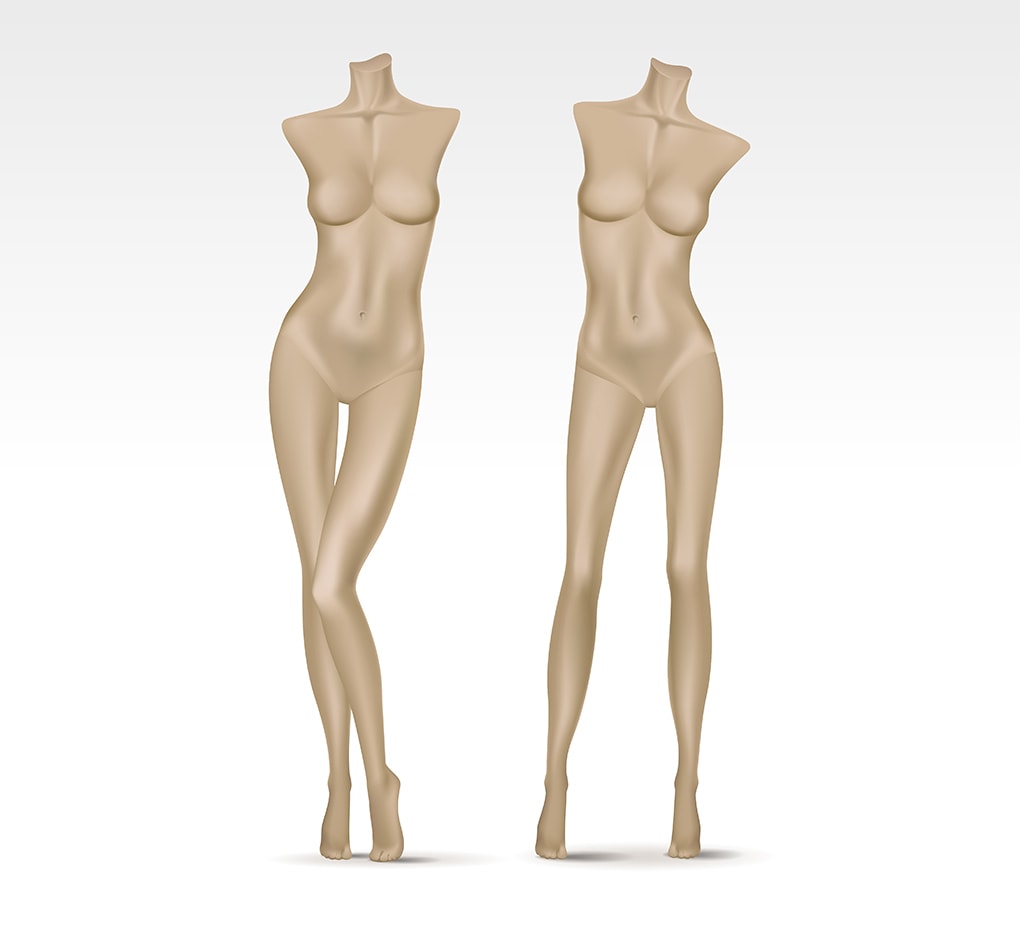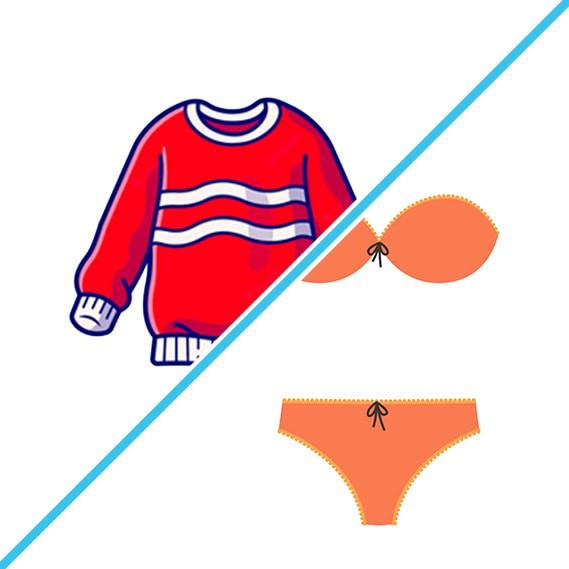What is it about swimwear that makes people anxious?
If you sometimes experience negative feelings about wearing, shopping, or even thinking about swimwear, this article is for you. Swimsuits do negatively affect the mind, but not necessarily in the way you might think. We'll be talking a little bit about psychology, design, scientific experiments and more in an effort to help you enjoy your swimwear.

We are Calypsa, a team of designers, researchers, and more. Almost 1,000,000 swimsuits have already been sold, and we continue to sell them worldwide. It is our mission to change how women feel about swimwear, to boost their confidence, and to increase their comfort. We started by listening to what you had to say about swimwear and got thousands of customer responses that they finally feel comfortable going to the beach or pool after years of avoiding it. We decided to dive into the research to find out why so many women feel uncomfortable in today's swimsuit options.
We strongly believe that listening to our customers and using scientific research and special design insights is the best way to tackle the negative feelings associated with swimwear. Scientific articles and studies will be cited and presented throughout this article.
Getting into it - The Basics:
Let's quickly explore how bad feelings are created. All feelings are created very fast and they change how we experience the world. When we experience something that we unconsciously evaluate as harmful in any way, we feel bad. If we evaluate the experience as beneficial, we feel good.

For a person to evaluate something, that something must be represented in the mind in some way. When we evaluate tools or pictures, this evaluation works great. But, sometimes, we start evaluating people (does she look good in those leggings? Is red the color for me? etc...). We turn a person into a represented object that we evaluate in our mind. E.g. in order to evaluate if red is the color for me, I would have to imagine or see myself wearing red.
Which brings us to objectification:
Objectifying has many meanings and levels; most definitions can be narrowed to "seeing and/or treating a person as an object" (1). When we objectify a person, that person is reduced to a body and appearance. They lose their past experiences and feelings, they no longer have a voice, nor do they have their own purpose. The objectified person becomes a tool for the objectifier. An objectified person is not a person in the eyes of the objectifier, they become a body that is judged by its appearance and uses (like an object). Both men and women objectify and are objectified.

Living in a world and culture that objectifies people causes many people to adopt a specific view of themselves (2). Objectification theory states that when you grow up in a culture that is filled with objectifications, you start to treat yourself as an object, to be judged by appearance and uses. This effect is called self-objectification.
AND SO, WE GROW UP THINKING WE NEED TO LOOK LIKE THIS IN A SWIMSUIT

Self-objectification also produces feelings of shame and anxiety (2). Shame happens when we negatively judge ourselves while also thinking about social exposure. Mass media sets the "ideal" body for women and men, and many people internalize this ideal. And while only 1 in 40,000 women actually meet this "ideal" body (3), we continuously see these "ideals" as the object to be evaluated against. So, basically, people see themselves as objects and judge "the object" by evaluating it against a mythical "ideal". When these feelings come with the notion that others might see them, they feel shame - the desire to hide, escape, or disappear (2). And when people feel shame from just thinking about certain situations, they're more likely to avoid those situations.
Anxiety manifests itself as muscle tension, alertness, and scanning (5). Anxiety from appearance causes us to check and adjust our appearance frequently (4). The fashion industry and "ideals" create multiple opportunities for anxiety (how a bathing suit needs to look from each direction, if too much skin is showing, or not enough, etc.). These make us pay more and more attention to the clothes we wear.
That's not to say that everyone constantly views themselves as objects. Throughout the day and life, we all go in and out of many contexts, most of which have nothing to do with self-objectification, or even viewing others as objects. We are going to focus specifically on swimwear and self-objectification which is a topic that has been heavily researched.
A Facebook comment we got that drove this research (it seems like she either met the ideal, or stopped self-objectifying altogether - and we are trying to understand how our swimsuits achieved that):




Another comment we got (it seems that she experienced less appearance related anxiety):


Another comment we got (it seems that she experienced less appearance related anxiety):


So just to sum up:
Everyone is objectifying and is being objectified.
Mass media and the fashion industry create "ideal" appearances.
People frequently subconsciously objectify themselves and evaluate their body against the "ideal".
Self-objectification can easily create feelings of shame and anxiety.
The Experiment: The Swimsuit-Sweater Paradigm
The self-objectification researchers created an experiment to test how much objectifying ourselves affects us. They conducted an experiment to see how much clothing affects mental capabilities. Specifically, in this case, whether clothing affected participants' math skills. All participants' previous math skills were evaluated to have a baseline performance. They were then given either a swimsuit or sweater to wear and several math problems to solve.

The experiment revealed that both men and women performed worse while wearing a swimsuit rather than a sweater (7). Meaning, self-objectification occupied the participants' minds so much that it affected everything they did. Nothing they did got their full attention.
What this means to us is that a lot of people are constantly evaluating themselves and thinking about their body when they wear a swimsuit which affects how they experience the world around them. Their minds use so much "brain power" to keep this self-objectification state, that not much is left for actually enjoying the water and the people with them.
Another comment we got (she was finally able to give her full attention to her grandkids!):


Another comment we got (she was finally able to give her full attention to her grandkids!):


It's NOT your fault that you objectify yourself
Our minds are built to evaluate everything around us. The culture and media determine what we should strive to get and be. While the classic normalized fashion industry taught us what the "ideal" bodies were, our minds unconsciously learned that we should also have those "ideal" bodies. And so, people see themselves as objects that need to meet some mythical standard.
Today we can see the many efforts of fashion companies and brands to include more and more body types in showing their swimwear. But they are missing the intrinsic issue. The designs themselves are created for the "ideal". They are created with appearance only in mind. So showing more body types may be a good step, but it's not enough. We must change the fashion itself. The fashion should be designed and created for all women and for all activities.

We are well into the 21st century
Technology is all around us and is being used to solve so many issues. How come the swimwear fashion isn't using the scientific body of knowledge to make swimwear better? To solve the human issues with wearing a swimsuit? It's probably because it's much easier to tell people they must change their bodies or minds, instead of changing the product.
We design and create swimsuits that reduce self-objectification and increase the comfort factor by learning, trying, listening to our customers, and incorporating their ideas and requests in our swimwear designs. The final products are stylish, versatile, comfortable, and generally cause the "finally, I can wear a bathing suit" sigh of relief.
What else did we include in our designs? (Customer comments give us ideas...)


All of our fabrics are UPF +50. Why? Because of science - that's why. UPF (Ultraviolet Protection Factor) rating measures the UV protection of a fabric. UPF 50+, which is the highest rating, allows only 2% of UV radiation to pass through the fabric which protects the skin for longer. It should be said that sunscreen is still recommended for exposed skin and for areas that maybe get exposed.
Which then drove this comment:


Several of our tops have built-in bras, and some don't.




Not sure about buying a swimsuit online? Not to worry! Our size charts are true to size and our customer service team is ready to help you with the sizing and fit as well. We are also happy to help you with an exchange or return. We want to make sure that the swimwear you ordered fits you and your needs perfectly!


All of our fabrics are UPF +50. Why? Because of science - that's why. UPF (Ultraviolet Protection Factor) rating measures the UV protection of a fabric. UPF 50+, which is the highest rating, allows only 2% of UV radiation to pass through the fabric which protects the skin for longer. It should be said that sunscreen is still recommended for exposed skin and for areas that maybe get exposed.
Which then drove this comment:


Several of our tops have built-in bras, and some don't.




Not sure about buying a swimsuit online? Not to worry! Our size charts are true to size and our customer service team is ready to help you with the sizing and fit as well. We are also happy to help you with an exchange or return. We want to make sure that the swimwear you ordered fits you and your needs perfectly!
Worried about standing out? As more and more are wearing Calypsa swimwear, we begin to see these in beaches/pools/waterparks/rivers/sport events and more. We've set out to change what conventional swimwear looks like and by wearing your Calypsa swimsuit, you're helping us with that mission! Be the first to enjoy comfortable swimwear :)
Not sure what kind of swim set you'd like? That's not a problem for us! We give you the ability to build your dream swim set by mixing and matching our tops, bottoms, sizes, and colors to make a swim set that suits you to a tee! With 40+ tops and bottoms and a size range of XXS-6X, we have something for everyone.
So what are you waiting for? Come check out a different kind of swimwear!!
Citations:
1 - Papadaki, Evangelia (Lina), "Feminist Perspectives on Objectification", The Stanford Encyclopedia of Philosophy (Spring 2021 Edition), Edward N. Zalta (ed.)
2- Barbara L. Fredrickson; Tomi-Ann Roberts (1997). OBJECTIFICATION THEORY : Toward Understanding Women's Lived Experiences and Mental Health Risks. , 21(2), 173–206. doi:10.1111/j.1471-6402.1997.tb00108.x
3- Wolf, N. (1991). The beauty nzyth: How images .f beauty are used against women. New York:
Anchor Books
4- Keelan, J. P., Dion, K. K., & Dion, K. L. (1992). Correlates of appearance anxiety in late adolescence
and early adulthood among young women. Journal of Adolescence, 15, 192-205.
5- DSM-IV, American Psychiatric Association [APA]
6 - Fredrickson BL, Roberts TA, Noll SM, Quinn DM, Twenge JM. That swimsuit becomes you: sex differences in self-objectification, restrained eating, and math performance. J Pers Soc Psychol. 1998 Jul;75(1):269-84. doi: 10.1037//0022-3514.75.1.269. PMID: 9686464.
7 - Hebl, M. R. (2004). The Swimsuit Becomes Us All: Ethnicity, Gender, and Vulnerability to Self-Objectification. Personality and Social Psychology Bulletin, 30(10), 1322–1331. doi:10.1177/0146167204264052 s